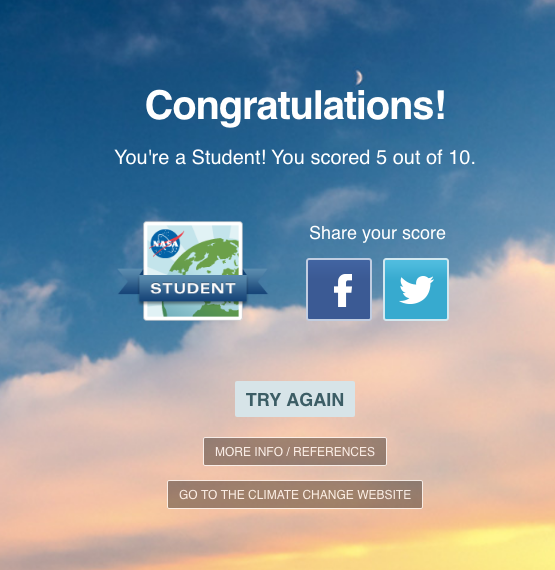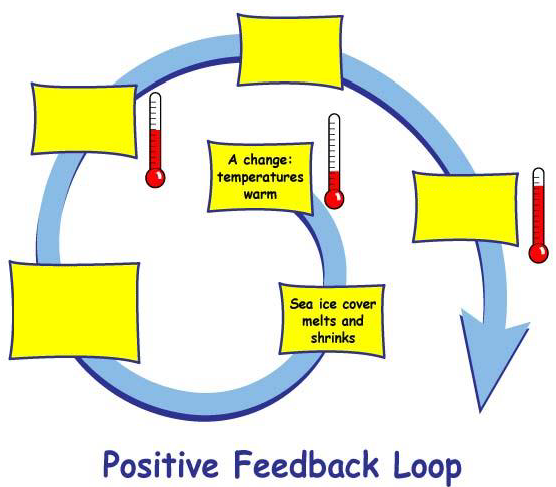Lesson Plans
The Frozen Poles Quiz
Overview
How much do you know about the frozen poles of our home planet?
You can browse a gallery containing this quiz and others at the Know Your Earth Quiz Collection. The current phase of the Know Your Earth Project aligns to the larger NASA Earth Right Now Campaign through the creation of NASA Earth science quizzes. The quizzes focus on current NASA Earth science research topics and will be centered on an Earth science theme. The Earth Right Now campaign is a largescale, NASA-wide campaign that, at its focal point, are the five NASA Earth science missions. The quizzes will highlight these missions during their respective launch and will highlight many NASA Earth science airborne and field campaigns.
We hope you enjoy learning more about NASA Earth Science and all the vital data and information that can be used to better understand our planet.
Materials Required
Computer
Procedure
Students individually take a 10 question quiz on their understanding of the Cryosphere. Students receive a score after they complete the quiz.
Disciplinary Core Ideas:
- ESS1C: The History of Planet Earth
- ESS2B: Plate Tectonics and Large-Scale Systems
- ESS3B: Natural Hazards
Crosscutting Concepts:
Science and Engineering Practices:
- Obtaining, Evaluating and Communicating Information
- The student will assess his/her current understanding of the Cryosphere system through an online quiz.

- Ice sheets are made of snow that builds up and gets compressed into ice, which then flows downhill toward the coast. What controls the mass of the Greenland and Antarctica ice sheets? Ice sheets lose mass when snow and ice at the surface melts and runs off and when ice at the coast enters the neighboring ocean. The three processes of snow accumulation, surface melt and ice loss make up what is known as an ice sheet's "mass budget."
- What is the coldest part of an ice sheet? Somewhat counterintuitively, an ice sheet's surface — the area exposed to the air — is its coldest part. This is because snow and ice act as insulation, trapping heat that rises from the bedrock below. Greenland's ice sheet, for example, is melting at its base in several places.
- "Albedo" is a measure of an object's "brightness" — i.e., how much of the sunlight that hits the surface is reflected away. Which has a higher albedo? Ice is bright and helps cool the polar regions. It has an albedo of about 80 percent, so it reflects away most of the incoming sunlight. When sea ice melts, it exposes the dark ocean beneath. The ocean, in contrast, has an albedo of just 10 percent, meaning it absorbs 90 percent of the incoming sunlight. As the Arctic warms in response to global warming, sea ice melts and amplifies global warming by reducing the Arctic albedo further.
- What is the main difference between the Arctic (North Pole) and the Antarctic (South Pole)? The Arctic consists of the Arctic Ocean covered by sea ice, which is surrounded by treeless permafrost (permanently frozen land). That land includes parts of Russia, Canada and the island of Greenland. Antarctica is a vast continent covered in a layer of snow and ice 2 km thick on average, which is surrounded by the Antarctic Ocean.
- When sea ice in the polar regions shrinks or grows, it affects: Major changes in sea ice cover affect many species, including polar bears living in the Arctic and penguins living in the Antarctic. Polar bears rely on sea ice as a platform for mating, rearing young and for hunting seals. As Arctic ice shrinks, their habitat disappears. Changes in the ice also affect the atmosphere and ocean circulation patterns, as the ice provides strong insulation between those two parts of the climate.
- T/F: Melting sea ice could raise sea level by several meters. Melting sea ice cannot raise global sea level since the ice is already floating. (Think of an ice cube melting in a glass full of water, which doesn't raise the water level.) However, Arctic sea ice is thinning and the long-term summer average cover has decreased by 34 percent in 1979. Ice from glaciers and ice sheets, which form on land, does add water to Earth's oceans when it melts and does contribute to sea level rise.
- Since 1958, Arctic ice cover has lost how much of its thickness at the end of summer? 2/3. Older ice has also shrunk in area by almost 800,000 square miles (more than 2 million square kilometers).
- Ice cap melting from which land mass(es) can affect Earth's spin? When the ice on Greenland and Antarctica melts, the water runs off into the oceans. NASA's Gravity Recovery and Climate Experiment (GRACE) satellites have shown that this huge flow of water changes the distribution of mass on Earth's surface. Meltwater from the polar ice caps entering the oceans measurably affects the axis of Earth's spin.
- T/F: Sea ice is frozen sea water. Sea ice is starts out as frozen sea water. It forms once the temperature of the water's surface drops below its freezing point. For salty ocean water, that's about 29°F (-2°C). (The salt impurities make the freezing point lower than that of pure water.) In contrast, icebergs, glaciers and ice shelves are made from freshwater, which comes from precipitation on land and other sources. because it makes it seem like sea ice is frozen seawater, with all the salt retained. As sea ice ages it rejects the salt, with the oldest sea ice being essentially pure water.
- What proportion of the world's freshwater is stored in glaciers and ice caps? The salty oceans contain more than 97 percent of all water on Earth, making freshwater relatively scarce. A bit over 69 percent of Earth's freshwater is held in ice caps and glaciers. The rest resides in lakes (27 percent), swamps (3 percent) and rivers (less than 1 percent).
- One-to-One (tablet, laptop, or CPU)


